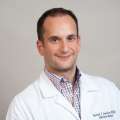In the 40 years since AIDS was first identified at UCLA, the university continues to be at the forefront of research and clinical advances that have transformed the disease from an almost-certain death sentence to a treatable chronic illness.
“It’s been stunning and spectacular to see people going from trying to survive from one birthday to the next to being able to live a full life,” says Judith Currier, MD, chief of the UCLA Division of Infectious Diseases and director of the UCLA Clinical AIDS Research and Education (CARE) Center.
That transformation began in the 1990s, with the advent of three antiretroviral medications — the “cocktail” known as highly active antiretroviral therapy (HAART), and now more commonly known as antiretroviral therapy (ART) — that could durably suppress the virus to the point that it was no longer detectable. UCLA was a site for many of the pivotal multicenter studies, with investigators whose work informed the treatments.
The CARE Center, which originated as a small clinic at UCLA in 1983, two years after AIDS was identified, continues to be a focus for both research and clinical care. Raphael Landovitz, MD, is among the infectious-diseases experts engaged in research at the center, where he leads the effort to develop long-acting injectable pre-exposure prophylaxis (PrEP), a daily pill that greatly reduces the risk of acquiring H I V, a nd p o s t- e x p o su re prophy l a x i s (PEP), medication that can lower the risk of becoming HIV-positive if started within three days of exposure. “It used to be that all we could offer were behavioral strategies, like ‘use a condom,’” Dr. Landovitz says. “My arrival at UCLA (in 2006) coincided with an explosion in our understanding of what was possible and opportunities to develop and implement these strategies as part of our prevention tool kit.”
A vaccine against HIV remains an ultimate goal. “We’re still hopeful that we will, at some point, have a protective vaccine against HIV,” says Dr. Landovitz, who also is codirector of the Center for HIV Identification, Prevention and Treatment Services. It is a dream that scientists have been pursuing, without success, for decades. “We hoped that we would be closer than we are right now. The unfortunate truth is, we’re as far away today as we were 40 years ago,” he says.
Still, the pursuit of a vaccine against AIDS may now benefit from advances in mRNA technology made by COVID-vaccine researchers — advances that derived in part from decades of HIV research.
And work to treat AIDS is continuing on other fronts, as well. Recent laboratory research led by UCLA Health scientists has amplified earlier developments into a treatment strategy called “kick and kill” to target HIV-infected cells and reduce, or even eliminate, the amount of virus in an infected individual. The approach utilizes a synthetic compound, administered in combination with antiretroviral drugs, to coax infected cells out of hiding and then kill them. “Our findings show proof of concept for a therapeutic strategy to potentially eliminate HIV from the body, a task that had been nearly insurmountable for many years,” says UCLA infectious-diseases specialist Jocelyn Kim, MD. Such bench research lays the groundwork for future clinical studies. “The study opens a new paradigm for a possible HIV cure in the future,” Dr. Kim says.
“It’s been stunning and spectacular to see people going from trying to survive from one birthday to the next to being able to live a full life.”
Even with such dramatic scientific advances, stigma remains a significant barrier to care for many patients with AIDS. “Until we remove the stigma attached to an HIV diagnosis, we’re never going to encourage people who a re most at risk a nd most disenfranchised from medical interventions to come forward and get tested so that we can move to the next step,” Dr. Landovitz says.
“There’s a percept ion t hat bec ause treatments have become effective and welltolerated, the work is finished. But that’s not at all true,” he says. “There are many critical correlates of the stigma associated with AIDS, including racism, sexism, homophobia, transphobia, addiction-phobia and attitudes around mental health disorders, that are preventing us from reaching populations that are most affected by HIV. Until we acknowledge some obvious truths, we are not going to move forward to destigmatize this disease,” Dr. Landovitz continues. “We need to make it possible and acceptable for people to seek, without fear, the treatment, care or preventive services they need to end this epidemic.”



